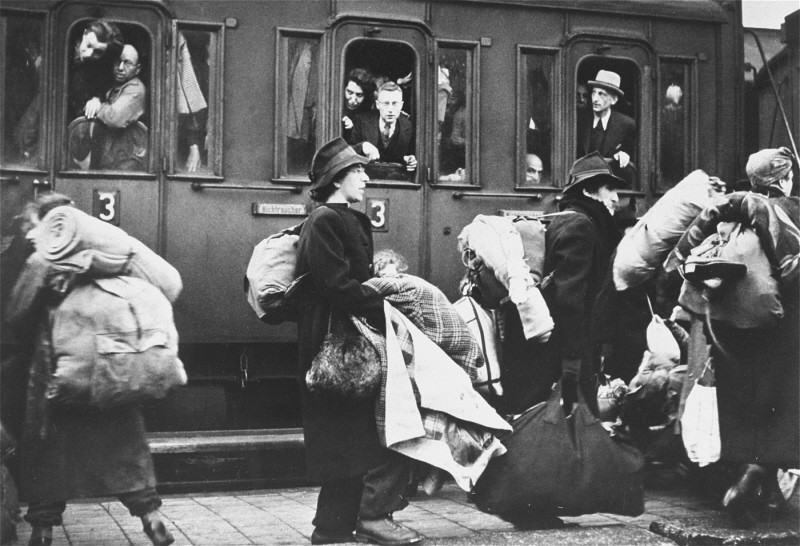
German Railways and the Holocaust
The Wannsee Conference was held on January 20, 1942, in Berlin, to coordinate the implementation of the proposed "Final Solution." At Wannsee, the SS estimated that the "Final Solution"—which was already under way—would ultimately involve 11 million European Jews. Nazi planners envisioned the inclusion of Jews living in neutral or non-occupied countries such as Ireland, Sweden, Turkey, and Great Britain.
The European rail network played a crucial role in the implementation of the "Final Solution." Jews from Germany and German-occupied Europe were deported by rail to the killing centers in German-occupied Poland. The Germans attempted to disguise their deadly intentions, referring to these deportations as "resettlement to the east." The victims were told they were being taken to labor camps, but in reality, from 1942, deportation for most Jews meant transit to killing centers.
Deportations on this scale required the coordination of numerous German government ministries and state organizations, including the Reich Security Main Office (RSHA), the Transport Ministry, and the Foreign Office. The RSHA coordinated and directed the deportations; the Transport Ministry organized train schedules; and the Foreign Office negotiated with German-allied states about handing over their Jews.
The Germans used both freight and passenger cars for the deportations. They did not provide the deportees with food or water, even when the transports had to wait days on railroad spurs for other trains to pass. The people deported in sealed freight cars suffered from intense heat in summer, freezing temperatures in winter, and the stench of urine and excrement. Aside from a bucket, there were no provisions for sanitary requirements. Without food or water, many deportees died before the trains reached their destinations. Armed guards shot anyone trying to escape. Between the fall of 1941 and the fall of 1944, millions of people were transported by rail to the killing centers and other killing sites in German-occupied Poland and the occupied Soviet Union.

Dimensions of the Railway Car on Display at the United States Holocaust Memorial Museum
There were many different kinds of railway cars used for deportations, varying in size and weight. The railway car on display in the Museum's Permanent Exhibition is of just one type used.
To give a sense of how the railway cars varied in size, we have provided the dimensions of the railway car on display along with the dimensions of the average freight car used for deportations in Hungary. It is not certain that the rail car on display in the Museum's Permanent Exhibition was used for the deportation of human beings, but it is typical of the type of rail car used in deportations from the German Reich.
Dimensions of the railway car on display:
- Total length 31 feet 6 inches (9.6 meters); interior space for deportees 26 feet 2 inches (8 meters).
- Total height 14 feet (4.3 meters) from the bottom of the wheel to the highest point of the car; interior space for deportees (ceiling curves down from the middle): 7 feet 4 inches (2.2 meters ) at the center; 7 feet (2.1 meters) at the sides.
- Total width 10 feet 1 inch (3.1 meters, including the roofing); interior space for deportees: 8 feet 10 inches (2.7 meters).
Dimensions of the average freight car used for deportations in Hungary:
- Length: 26.8 feet (8.2 meters)
- Width: 7.2 feet (2.2 meters)
Source for Hungarian railway car dimensions: Randolph L. Braham, The Politics of Genocide: The Holocaust in Hungary, Volume 1 (New York: The Rosenthal Institute for Holocaust Studies, 1994), p. 686.
Note for Teachers
The Museum provides the dimensions of the railway car because of its significance as a historical artifact. However, please refer to the Museum's teacher guidelines for information about the dangers of simulating (based on a set of physical dimensions) the experience of deportation during the Holocaust. For a discussion of the dangers of classroom simulations and role plays about the Holocaust, please see the guideline about making responsible methodological choices.
Critical Thinking Questions
- Consider all of the occupations, staff, and workers that must participate in the movement of millions of people on the railroad system. Do they bear any responsibility for the tremendous loss of life in the Holocaust?
- Investigate what train systems brought Jews to camps and ghettos from all over Europe? Who managed the trains involved, outside of German borders. What questions does this raise?